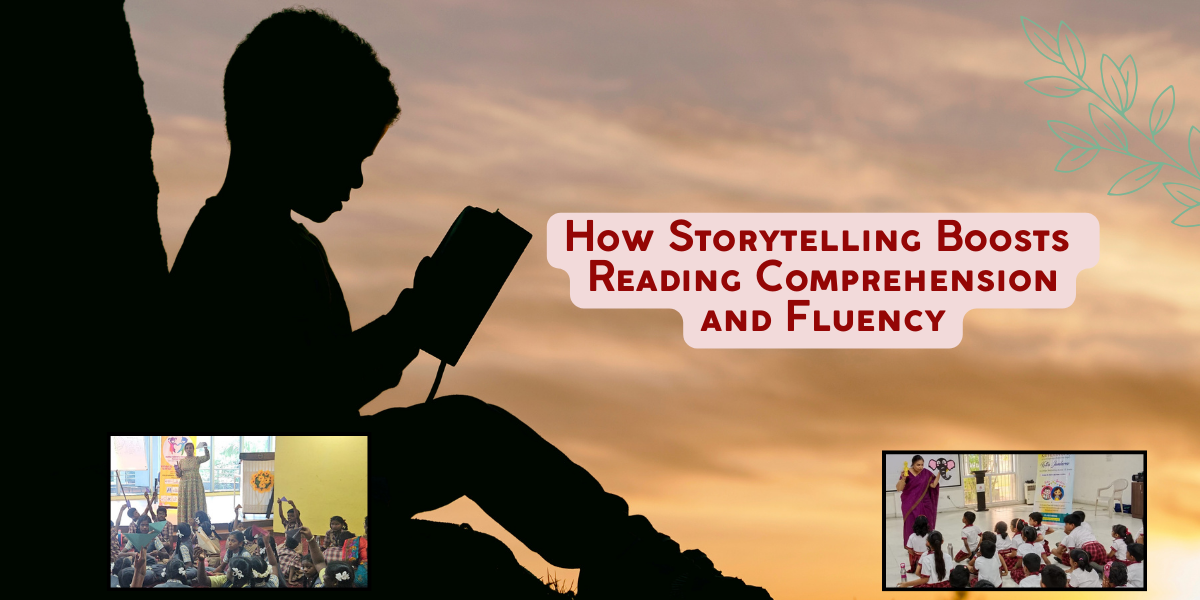
From Tales to Text: How Storytelling Boosts Reading Comprehension and Fluency
How Storytelling Boosts Reading Skills and Comprehension in Children
Storytelling is often regarded as an art form particularly suited for imparting morals, values, and cultural knowledge. However, it can also be effectively utilized as a pedagogical tool in academics, especially for developing reading skills and enhancing child literacy development.
Why Storytelling is Essential for Developing Reading Skills
Reading skills are the foundation of literacy. But is enabling reading skills merely about developing phonemic awareness, phonics, and the ability to read words and sentences? While these are essential components, true reading proficiency cannot be fully achieved without also fostering reading comprehension.
The most challenging aspect of fostering comprehension involves building context, expanding vocabulary, and developing critical thinking skills. Unfortunately, many children in our country lack these foundational skills in the language they are learning, leading them to view reading as a chore rather than a joyful activity.
How Storytelling Can Enhance Comprehension
Is there an effective solution to this problem? Yes, storytelling comes to the rescue. Although primarily an oral skill, storytelling allows tellers to connect with listeners directly. The storyteller has the power to transport listeners on a magic carpet to the world of stories, enabling them to visualize vivid images, think through situations, and fully immerse themselves in the narrative. As the story concludes, listeners return to the real world with a fresh set of contexts, vocabulary, and insights drawn from the story.
These contexts, words, and insights form the basis for reading comprehension, vocabulary, and critical thinking skills. Therefore, it is crucial to incorporate storytelling into the learning process when teaching children to read.
Building Vocabulary Through Storytelling
To build context effectively, it’s important to tell stories from all walks of life. Especially stories set in diverse environments—such as forests, mountains, skies, and various landforms—as well as those that explore a wide range of emotions, relationships, and daily settings like roads, parks, beaches, towns, villages, and cities. During storytelling, it is important to describe the settings for children to imagine vivid imagery.
Using pictures that help children associate the words with images will also help them develop context and vocabulary for unfamiliar words. For example, in a story that takes place in a village, the storyteller might say: Children run barefoot along the narrow, winding paths. The laughter—ha ha ha—(ask children to laugh together) mixes with the sounds of chirping birds and clucking chickens. (Groups of children can imitate the birds and chickens.) Showing a picture of winding paths will help children connect with the word “winding.”
Enhancing Comprehension and Reading Fluency
Storytellers or educators can carefully curate stories, choosing vocabulary and preparing story cards based on targeted learning outcomes. This requires thoughtful planning. These stories help children imagine different contexts, enabling them to connect meaningfully with the content. As their comprehension improves, so does their reading fluency, making them more comfortable with reading. When children are comfortable doing something, they’re more likely to engage in it frequently and without stress, increasing the chances that reading will become one of their most loved activities.
Incorporating Storytelling in Classrooms and Homes
At Little Laudable Learners, storytelling is an integral part of our curriculum as a pedagogical tool to foster a love for reading and learning. By weaving rich, imaginative narratives into lessons, educators can ignite children’s curiosity, build their comprehension, and foster a lifelong love for reading.
How You Can Start Today
As educators and parents, let’s embrace the magic of storytelling to transform the way our children learn to read. By integrating storytelling into your lessons or daily interactions, you will not only enhance children’s vocabulary and comprehension but also make reading an enjoyable and immersive experience.
Actionable Tips:
- Curate diverse stories: Include narratives set in different environments and cultural contexts to expand vocabulary.
- Incorporate interactive storytelling: Let children mimic sounds and actions from the story to enhance engagement.
- Use visual aids: Pictures related to story settings can help children connect words with images, deepening their understanding.
- Plan story outcomes: Choose stories that align with specific learning goals, like new vocabulary or comprehension skills.
Let storytelling become the bridge that connects your students to the joy of reading, fostering critical thinking and comprehension along the way!



